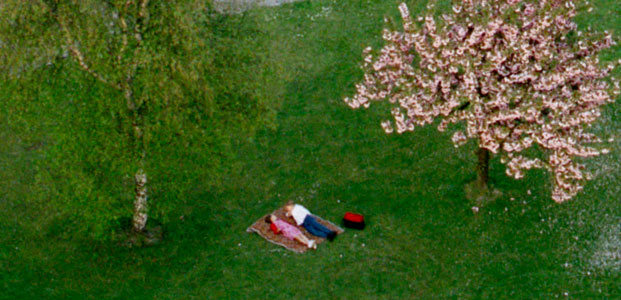LOOP
'00 Barcelona 2003
Nov 27 - Nov 30, 2003

Presented artist: Corinna Schnitt
Sreened
film: DAS NÄCHSTE MAL | NEXT TIME, 2003, 16mm, colour, 6 min
It’s spring, two children lie on the grass, leading a peculiar sort
of love dialogue. They exchange trite phrases like, “Listen to your
heart,” and cliched notions like “Be ro-mantic for once!”,
but also try out gender specific dialogue roles and modes of be-havior
in a playful way. Then the camera pulls back from the site of action,
and the romantic garden proves from a distance to be the small grassy
surface of a traffic island, an island of escape of traditional love fantasies
in the midst of noisy reality, staged images of longing on the stage of
the imaginary. The “island of lovers,” this paradise, proves
to be a product of conditioning and media phantasms of the idyll of relationship.
The artificiality of the situation results from the dialogues, which seem
to be taken from other films or instructions, and to have nothing to do
with the ac-tors. The discrepancy between language and the speaking subjects
points to the stereotypical schemata of communication that still have
to be trained or completed by the actors, next time.
Sabine Winkler
Living
a beautiful life, 2003
Mini DV/ colour/ 13 min
Imagine a life you always dreamed of as a child? A perfect life.
In a way that seems entirely naïve, Corinna Schnitt takes the common wish and the usual notion of a happy life literally, and then presents them mercilessly before our eyes and ears in a quasi-documentary setting. It shows a woman and a man, both good-looking, who live in a tasteful villa high above Los Angeles, reporting alter-nately to the camera that they own all the things about them, and that this is what others can only dream of. Like Blade Runner replicants, they list all the components of the beautiful life, at least as it is imagined in the Western world. The spectator is only barely able to take this exhausting litany of total happiness, and feels himself further provoked by the contemplative mood of these well-composed scenes. And if in the meantime you think that everything will explode at the end, like in Antonioni’s Zabriskie Point, you’re wrong.
As
grotesque as this wallowing in cliches of the beautiful might seem, Corinna
Schnitt goes far beyond simple parody, and refuses to use cheap effects
or to make easy points. She is a master of the dramaturgically effective
method of subtly weav-ing together the artificial and the naturalistic.
This is a fundamental aspect of Schnitt’s film work: she leaves
us—perhaps even with a bit of malicious pleasure––with
an irritating ambivalence, which insures an undecidedness that is in one
moment amusing, then disconcerting. In her strange, ethnological fictions,
she uncovers para-realities just where we thought we already knew it all,
and thus very gently and very friendly pulls the floor from beneath our
feet while we watch these barely moving images.
Kay von Keitz